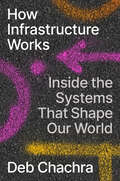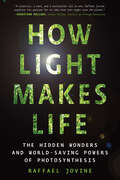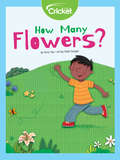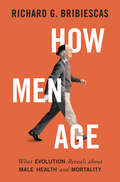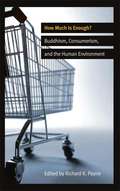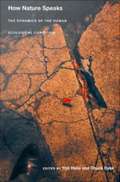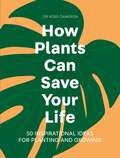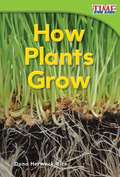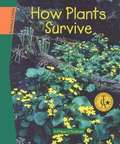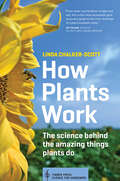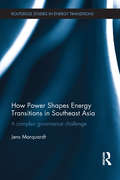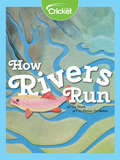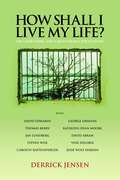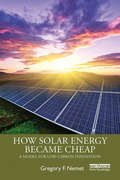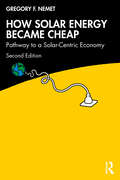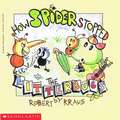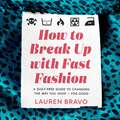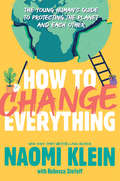- Table View
- List View
How Infrastructure Works: Inside the Systems That Shape Our World
by Deb ChachraNAMED A BEST BOOK OF 2023 BY PUBLISHERS WEEKLY"Revelatory, superbly written, and pulsing with wisdom and humanity, How Infrastructure Works is a masterpiece.&” —Ed Yong, author of An Immense WorldA new way of seeing the essential systems hidden inside our walls, under our streets, and all around us Infrastructure is a marvel, meeting our basic needs and enabling lives of astounding ease and productivity that would have been unimaginable just a century ago. It is the physical manifestation of our social contract—of our ability to work collectively for the public good—and it consists of the most complex and vast technological systems ever created by humans. A soaring bridge is an obvious infrastructural feat, but so are the mostly hidden reservoirs, transformers, sewers, cables, and pipes that deliver water, energy, and information to wherever we need it. When these systems work well, they hide in plain sight. Engineer and materials scientist Deb Chachra takes readers on a fascinating tour of these essential utilities, revealing how they work, what it takes to keep them running, just how much we rely on them—but also whom they work well for, and who pays the costs. Across the U.S. and elsewhere, these systems are suffering from systemic neglect and the effects of climate change, becoming unavoidably visible when they break down. Communities that are already marginalized often bear the brunt of these failures. But Chachra maps out a path for transforming and rebuilding our shared infrastructure to be not just functional but also equitable, resilient, and sustainable. The cost of not being able to rely on these systems is unthinkably high. We need to learn how to see them—and fix them, together—before it&’s too late.
How Light Makes Life: The Hidden Wonders And World-saving Powers Of Photosynthesis
by Raffael JovineA revelatory journey of discovery into the intricate, beautiful, and often surprising processes that convert energy from the sun into life, and how all-important these are to our survival—and our planet’s future It’s a clunky word for a miracle: Photosynthesis. But there’s no life on Earth without it. For biologist Raffael Jovine, it’s a consuming passion, a great unsung force of nature. He makes his case in How Light Makes Life, a catalog of living wonders—and a blueprint for a better planet. Imagine harvesting pure sunlight to use as fuel, while turning carbon dioxide into breathable oxygen. This is what a leaf does every day. And photosynthesis isn’t just for plants: Corals partner with photosynthetic organisms to create the most productive habitat on Earth. Slugs eat chloroplasts as natural green camouflage. Hornets use photosynthesis as an innovative means of air-conditioning—and much more! The revelatory vision of How Light Makes Life is how we ourselves might harness the power of photosynthesis: to repair ecosystems, stabilize the climate, and grow more food sustainably. On this vivid journey, you’ll see how every seed contains the key to our future—through the photosynthetic pigments in your own eyes!
How Many Flowers
by Amy TaoDo you know how new fruit is made? Learn about the different parts of a fruit plant’s flower—the stigma, pistil, and stamen—and how they use pollen to make seeds in a process called pollination! The seeds grow into new flowers, which turn into fruit after they’re pollinated!
How Men Age: What Evolution Reveals about Male Health and Mortality
by Richard G. BribiescasWhile the health of aging men has been a focus of biomedical research for years, evolutionary biology has not been part of the conversation--until now. How Men Age is the first book to explore how natural selection has shaped male aging, how evolutionary theory can inform our understanding of male health and well-being, and how older men may have contributed to the evolution of some of the very traits that make us human.In this informative and entertaining book, renowned biological anthropologist Richard Bribiescas looks at all aspects of male aging through an evolutionary lens. He describes how the challenges males faced in their evolutionary past influenced how they age today, and shows how this unique evolutionary history helps explain common aspects of male aging such as prostate disease, loss of muscle mass, changes in testosterone levels, increases in fat, erectile dysfunction, baldness, and shorter life spans than women. Bribiescas reveals how many of the physical and behavioral changes that we negatively associate with male aging may have actually facilitated the emergence of positive traits that have helped make humans so successful as a species, including parenting, long life spans, and high fertility.Popular science at its most compelling, How Men Age provides new perspectives on the aging process in men and how we became human, and also explores future challenges for human evolution--and the important role older men might play in them.
How Mountains Are Made (Let's-Read-and-Find-Out Science 2)
by Kathleen Weidner ZoehfeldRead and find out about how mountains are made in this colorfully illustrated nonfiction picture book.A mountain might be thousands of feet high, but it can still grow taller or shorter each year. This classic picture book explores how mountains are made—including how Mount Everest grew from a flat plain under an ocean to become 29,028 feet tall.How Mountains Are Made features simple activities and fascinating cross-sections of the earth’s moving crust that clearly explain plate tectonics. Both text and artwork were vetted for accuracy by an expert in the field.This is a clear and appealing science book for early elementary age kids, both at home and in the classroom. It's a Level 2 Let's-Read-and-Find-Out, which means the book explores more challenging concepts for children in the primary grades. The 100+ titles in this leading nonfiction series are:hands-on and visualacclaimed and trustedgreat for classroomsTop 10 reasons to love LRFOs:Entertain and educate at the same timeHave appealing, child-centered topicsDevelopmentally appropriate for emerging readersFocused; answering questions instead of using survey approachEmploy engaging picture book quality illustrationsUse simple charts and graphics to improve visual literacy skillsFeature hands-on activities to engage young scientistsMeet national science education standardsWritten/illustrated by award-winning authors/illustrators & vetted by an expert in the fieldOver 130 titles in print, meeting a wide range of kids' scientific interestsBooks in this series support the Common Core Learning Standards, Next Generation Science Standards, and the Science, Technology, Engineering, and Math (STEM) standards. Let's-Read-and-Find-Out is the winner of the American Association for the Advancement of Science/Subaru Science Books & Films Prize for Outstanding Science Series.
How Much is Clean Air Worth?
by Ari Rabl Joseph V. Spadaro Mike Holland Ari Rabl Joseph V. SpadaroHow Much is Clean Air Worth? offers readers a comprehensive overview of the core methodologies and tools used to quantify the impacts and damage costs of pollution. The book begins by reviewing the tools used for environmental assessments and shows that a rational approach requires an impact pathway analysis (IPA) for each of the possible impacts of a pollutant, i. e. an analysis of the chain emission ->dispersion ->exposure-response functions ->monetary valuation. The IPA methodology is explained in full and illustrated with worked examples, and difficulties are discussed and uncertainties analysed. In addition to detailed computer models, a very simple model (the 'Uniform World Model') is presented, enabling readers to make estimates for cases where no results are available. Published results for electricity, waste treatment and transport are reviewed, with a thorough discussion of policy implications. This book will appeal to a broad mix of academics, graduate students and practitioners in government and industry working on cost-benefit analysis, environmental impact analysis and environmental policy.
How Much is Enough?
by Richard K. PayneThe massive outpouring of consumer products available today might alone lead one to ask "How much is enough?" But at the same time, if we allow ourselves to see the social, political, economic and environmental consequences of the system that produces such a mass of "goods," then the question is not simply a matter of one's own personal choice, but points to the profound interconnectedness of our day to day decisions about "How much is enough?" The ease with which we can acquire massive quantities of food, clothing, kitchenware, and various electronic goods directly connects each of us with not only environmental degradation caused by strip mining in West Virginia, and with sweat shops and child labor in India or Africa, but also with the ongoing financial volatility of Western capitalist economies, and the increasing discrepancies of wealth in all countries. This interconnectedness is the human environment, a phrase intended to point toward the deep interconnection between the immediacy of our own lives, including the question of "How much is enough?," and both the social and natural worlds around us. This collection brings together essays from an international conference jointly sponsored by Ryukoku University, Kyoto, and the Institute of Buddhist Studies, Berkeley. The effects of our own decisions and actions on the human environment is examined from several different perspectives, all informed by Buddhist thought. The contributors are all simultaneously Buddhist scholars, practitioners, and activists - thus the collection is not simply a conversation between these differing perspectives, but rather demonstrates the integral unity of theory and practice for Buddhism.
How Nature Speaks: The Dynamics of the Human Ecological Condition
by Yrjö Haila Chuck DykeHow Nature Speaks illustrates the convergence of complexity theory in the biophysical and social sciences and the implications of the science of complexity for environmental politics and practice. This collection of essays focuses on uncertainty, surprise, and positionality--situated rather than absolute knowledge--in studies of nature by people embedded within the very thing they purport to study from the outside. The contributors address the complicated relationship between scientists and nature as part of a broader reassessment of how we conceive of ourselves, knowledge, and the world that we both inhabit and shape. Exploring ways of conceiving the complexity and multiplicity of humans' many interactive relationships with the environment, the contributors provide in-depth case studies of the interweaving of culture and nature in socio-historical processes. The case studies focus on the origin of environmental movements, the politicization of environmental issues in city politics, the development of a local energy production system, and the convergence of forest management practices toward a dominant scheme. They are supported by explorations of big-picture issues: recurring themes in studies of social and environmental dynamics, the difficulties of deliberative democracy, and the potential gains for socio-ecological research offered by developmental systems theory and Pierre Bourdieu's theory of intentionality. How Nature Speaks includes a helpful primer, "On Thinking Dynamically about the Human Ecological Condition," which explains the basic principles of complexity and nonlinear thinking. Contributors. Chuck Dyke, Yrj Haila, Ari Jokinen, Ville Lhde, Markus Laine, Iordanis Marcoulatos, John O'Neill, Susan Oyama, Taru Peltola, Lasse Peltonen, John Shotter, Peter Taylor
How Plants Can Save Your Life: 50 Inspirational Ideas for Planting and Growing
by Ross CameronGrowing plants and (if we are lucky enough) creating gardens is deeply rewarding, but has also been proven to be vital for our health.Gardening helps improve our mood, relax us, take us away from our everyday problems, and promote positive emotions. It reduces anxiety and stress, delays in the onset of dementia, promotes joy, as well as improving physical health and even self-esteem.This new book explores the ways we can introduce plants into our lives and thus embrace some of the benefits the natural world provides for our well-being. Divided into 50 sections, each one highlights a plant-based activity, how this is good for your health and provides links to the underlying concept that supports health and well-being.Written by a leading scientific authority on environmental horticulture, this unique book will offer readers a wealth of ideas on planting and growing as well as explaining the latest science research behind those ideas.
How Plants Can Save Your Life: 50 Inspirational Ideas for Planting and Growing
by Ross CameronGrowing plants and (if we are lucky enough) creating gardens is deeply rewarding, but has also been proven to be vital for our health.Gardening helps improve our mood, relax us, take us away from our everyday problems, and promote positive emotions. It reduces anxiety and stress, delays in the onset of dementia, promotes joy, as well as improving physical health and even self-esteem.This new book explores the ways we can introduce plants into our lives and thus embrace some of the benefits the natural world provides for our well-being. Divided into 50 sections, each one highlights a plant-based activity, how this is good for your health and provides links to the underlying concept that supports health and well-being.Written by a leading scientific authority on environmental horticulture, this unique book will offer readers a wealth of ideas on planting and growing as well as explaining the latest science research behind those ideas.
How Plants Grow (Time For Kids®: Informational Text)
by Dona Herweck RiceBeginning readers explore the steps to make plants grow! Readers will learn about various parts of the plant including seeds, roots, and leaves in this engaging nonfiction title. Featuring vivid, clear photos and simple, informational text, even the most reluctant reader will be captivated!
How Plants Survive (Science Links)
by Kathleen V. KudlinskiPlants compete with one another for sunshine and water, and they struggle to protect their own patch of soil. Find out how plants wage a constant battle for survival.
How Plants Work: The Science Behind the Amazing Things Plants Do (Science For Gardeners Ser.)
by Linda Chalker-ScottThe more you know, the better you grow! Plants are capable of interesting and unexpected things. Why do container plants wilt when they’ve been regularly watered? Why did the hydrangea that thrived last year never bloom this year? Why do slugs wipe out the vegetable garden instead of eating the weeds? Plant physiology—the study of how living things function—can solve these and most other problems gardeners regularly encounter.In How Plants Work, horticulture expert and contributor to the popular blog The Garden Professors, Linda Chalker-Scott brings the stranger-than-fiction science of the plant world to vivid life. She uncovers the mysteries of how and why plants do the things they do, and arms the home gardener with fascinating knowledge that will change the way they garden.
How Power Shapes Energy Transitions in Southeast Asia: A complex governance challenge (Routledge Studies in Energy Transitions)
by Jens MarquardtAn understanding of the role of energy-related governance systems and the conditions required for a shift towards renewables in developing countries is urgently needed in order to tap into the global potential of low-carbon development. Although renewable energy sources have become technically feasible and economically viable, social and political factors continue to persist as the most critical obstacles for their dissemination. How Power Shapes Energy Transitions in Southeast Asia conceptualizes power for the field of sustainable energy governance. Based on empirical findings from the Philippines and Indonesia, the book develops an analytical approach that incorporates power theory into a multi-level governance framework. The book begins with a profound background on renewable energy development around the world and presents major trends in development cooperation. A power-based multi-level governance approach is introduced that is rooted in development thinking. Examining how coordination and power relations shape the development and dissemination of renewable energy technologies, the book also shows how decentralization affects low carbon development in emerging economies. Sparking debate on the ways in which energy transitions can be triggered and sustained in developing countries, this book will be of great interest to students and scholars of renewable energy development and environmental politics and governance as well as practitioners in development cooperation.
How Rivers Run
by Liz HuyckHave you ever wondered how a river forms, which animals live near rivers, or where those rivers lead? Rivers are a vital part of life and the ecosystem. Rivers help transport water to humans and animals as well. It can also be used to create energy. Water from rivers can end up in many different places downstream!
How Shall I Live My Life? On Liberating the Earth from Civilization
by Derrick JensenInterviews with Vine Deloria, Jesse Wolf Hardin, David Abram, Kathleen Dean Moore, Carolyn Raffensperger, George Draffan, Steven Wise, Jan Lundberg, Thomas Berry, David Edwards. In this collection of interviews, Derrick Jensen discusses the destructive dominant culture with ten people who have devoted their lives to undermining it. Whether it is Carolyn Raffensperger and her radical approach to public health, or Thomas Berry on perceiving the sacred; be it Kathleen Dean Moore reminding us that our bodies are made of mountains, rivers, and sunlight; or Vine Deloria asserting that our dreams tell us more about the world than science ever can, the activists and philosophers interviewed in How Shall I Live My Life? each bravely present a few of the endless forms that resistance can and must take. Hailed as the philosopher poet of the ecological movement, Derrick Jensen is the widely acclaimed author of Endgame, A Language Older Than Words, The Culture of Make Believe (a finalist for the 2003 J. Anthony Lukas Book Prize), and Walking on Water, among many others. Jensen's writing has been described as "breaking and mending the reader's heart" (Publishers Weekly). Author, teacher, activist, and leading voice of uncompromising dissent, he regularly stirs auditoriums across the country with revolutionary spirit. He lives in Crescent City, California.
How Solar Energy Became Cheap: A Model for Low-Carbon Innovation
by Gregory F. NemetSolar energy is a substantial global industry, one that has generated trade disputes among superpowers, threatened the solvency of large energy companies, and prompted serious reconsideration of electric utility regulation rooted in the 1930s. One of the biggest payoffs from solar’s success is not the clean inexpensive electricity it can produce, but the lessons it provides for innovation in other technologies needed to address climate change. Despite the large literature on solar, including analyses of increasingly detailed datasets, the question as to how solar became inexpensive and why it took so long still remains unanswered. Drawing on developments in the US, Japan, Germany, Australia, and China, this book provides a truly comprehensive and international explanation for how solar has become inexpensive. Understanding the reasons for solar’s success enables us to take full advantage of solar’s potential. It can also teach us how to support other low-carbon technologies with analogous properties, including small modular nuclear reactors and direct air capture. However, the urgency of addressing climate change means that a key challenge in applying the solar model is in finding ways to speed up innovation. Offering suggestions and policy recommendations for accelerated innovation is another key contribution of this book. This book will be of great interest to students and scholars of energy technology and innovation, climate change and energy analysis and policy, as well as practitioners and policymakers working in the existing and emerging energy industries.
How Solar Energy Became Cheap: Pathway to a Solar-Centric Economy
by Gregory F. NemetThe climate problem is getting worse, but the solutions are getting better. So far, no technology has done more to improve the solutions available to address climate change than solar photovoltaics (PV). This revised edition describes an array of driving forces leading us toward a solar-centric energy system, one where solar power lies at the core rather than at the edge.Now in its second edition the book focuses on the future of solar, taking into account important changes since it was first published. It includes discussions on further growth and cost reductions, industrial policy, and grid integration of high solar. It has been fully revised to include the most recent data available, and includes two new chapters on India, the most important solar market in the Global South, and Australia, the fastest growing market for rooftop solar. The book concludes with a new chapter on a solar-centric economy. The costs of solar PV modules have reduced significantly since they were first commercialized and, in sunny places, are now cheaper than any other form of electricity. Drawing on developments in the US, Japan, Germany, Australia, India, and China, the book analyses the evolution and success of PV and asks how it can serve as a model for other low-carbon technologies, which require urgent innovation to address climate change.It will be of great interest to students and scholars of energy technology and innovation, climate change and energy analysis and policy, as well as practitioners and policymakers working in the energy industries.
How Spider Stopped the Litterbugs
by Robert KrausThe hero of this short story is a big, green, guitar playing spider who goes to bug school and has bug friends. His teacher is Miss Quito. A class picnic seems like a good idea until the bugs find litter dumped all over the park. They clean up the mess but before they can start having fun, a big gang of litterbugs come dumping more trash everywhere. It looks as if the little bugs will have to run back to school until Spider has a surprising idea that turns a spoiled picnic into a big party. Most of the pictures are described.
How Steven the Bear Invented S'mores (Steven the Bear)
by Scott HallHow Steven the Bear Invented S’mores is a read aloud picture book with fun life lessons and colorful illustrations. Steven the Bear and his friends are excited to go on their very first camping adventure. After being sure to pack and prepare well, the Bear Bunch heads out to find the perfect campsite. They set up camp and spend their day hiking, bird watching, and finding animals. After a day full of fun, Steven and the Bear Bunch sit down to toast marshmallows. That’s when Steven has a brilliant idea…? Join Steven the Bear and his friends in this first of many adventures!
How To Break Up With Fast Fashion: A guilt-free guide to changing the way you shop – for good
by Lauren Bravo'A funny, achievable guide' Observer'Lauren Bravo is one of my favourite writers' Dolly Alderton'Bravo will inspire you to repair, recycle and give old items a new lease of life' StylistYou probably know the statistics: global clothing production has roughly doubled in just 15 years, and every year an estimated 300,000 tonnes of used clothing ends up in UK landfill.Fast fashion is the ultimate toxic relationship. It's bad news for the planet, our brains and our bank balances. We can't go on like this; our shopping habits need an overhaul.Journalist Lauren Bravo loves clothes more than anything, but she's called time on her affair with fast fashion in search of a slower, saner way of dressing. In this book, she'll help you do the same.How To Break Up With Fast Fashion will help you to change your mindset, fall back in love with your wardrobe and embrace more sustainable ways of shopping - from the clothes swap to the charity shop. Full of refreshing honesty and realistic advice, Lauren will inspire you to repair, recycle and give your unloved items a new lease of life without sacrificing your style.Because fashion belongs to everyone, but no outfit should cost us the earth.
How To Break Up With Fast Fashion: A guilt-free guide to changing the way you shop – for good
by Lauren Bravo'A funny, achievable guide' Observer'Lauren Bravo is one of my favourite writers' Dolly Alderton'Bravo will inspire you to repair, recycle and give old items a new lease of life' StylistYou probably know the statistics: global clothing production has roughly doubled in just 15 years, and every year an estimated 300,000 tonnes of used clothing ends up in UK landfill.Fast fashion is the ultimate toxic relationship. It's bad news for the planet, our brains and our bank balances. We can't go on like this; our shopping habits need an overhaul.Journalist Lauren Bravo loves clothes more than anything, but she's called time on her affair with fast fashion in search of a slower, saner way of dressing. In this book, she'll help you do the same.How To Break Up With Fast Fashion will help you to change your mindset, fall back in love with your wardrobe and embrace more sustainable ways of shopping - from the clothes swap to the charity shop. Full of refreshing honesty and realistic advice, Lauren will inspire you to repair, recycle and give your unloved items a new lease of life without sacrificing your style.Because fashion belongs to everyone, but no outfit should cost us the earth.
How To Break Up With Fast Fashion: A guilt-free guide to changing the way you shop – for good
by Lauren BravoYou probably know the statistics: global clothing production has roughly doubled in just 15 years, and every year an estimated 300,000 tonnes of used clothing ends up in UK landfill. Fast fashion is the ultimate toxic relationship. It's bad news for the planet, our brains and our bank balances. We can't go on like this; our shopping habits need an overhaul.Journalist Lauren Bravo loves clothes more than anything, but she's called time on her affair with fast fashion in search of a slower, saner way of dressing. In this book, she'll help you do the same. How To Break Up With Fast Fashion will help you to change your mindset, fall back in love with your wardrobe and embrace more sustainable ways of shopping - from the clothes swap to the charity shop. Full of refreshing honesty and realistic advice, Lauren will inspire you to repair, recycle and give your unloved items a new lease of life without sacrificing your style. Because fashion belongs to everyone, but no outfit should cost us the earth. (P)2020 Headline Publishing Group Ltd
How To Change Everything: The Young Human's Guide to Protecting the Planet and Each Other
by Naomi Klein Rebecca StefoffA long-awaited guide to climate action and justice for young readers by bestselling, award-winning, internationally acclaimed writer and climate activist Naomi Klein.Temperatures are rising all over the world, leading to wildfires, droughts, animal extinctions and ferocious storms -- climate change is real. But how did we get to this state, and what can we do next? What if we could work to protect the planet, while also taking action to make life fairer and more equal for the people who live on it? We can -- if we're willing to change everything. In her first book written for young readers, internationally acclaimed, bestselling author and social activist Naomi Klein, with Rebecca Steffof, lays out the facts and challenges of climate change and the movement for climate justice. Using examples of change and protest from around the world, including profiles of young activists from a wide range of backgrounds, Klein shows that young people are not just part of the climate change movement, they are leading the way. How to Change Everything will provide readers with clear information about how our planet is changing, but also, more importantly, with inspiration, ideas, and tools for action. Because young people can help build a better future. Young people can help decide what happens next. Young people can help change everything.
How To Go Vegan: The why, the how, and everything you need to make going vegan easy
by VeganuaryGoing vegan is easy!Whether you're already a full-time vegan, considering making the switch or know someone who is, this book will give you all the tools you need to make the change towards a healthier, happier and more ethical lifestyle. How to Go Vegan includes...Why try vegan?Animal welfare, the environment, health benefits and your personal adventure.Vegan at homeSurprisingly vegan foods, reading labels, vegan ingredient essentials, easy replacements, how to be the only vegan in the familyVegan out in the worldEating out, eating at friends' houses, answering questions from loved ones, travelling veganLiving the vegan lifestyleMeal plans, tips and tricks, what to do if you're struggling, how to celebrate being a veganHow to go vegan. It's easier than you think.
